by Alexandra Steinmaßl
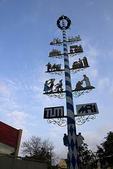
Always on the first of May in our region, the maypoles are set up.
It is a decorated tree, which is sometimes in the bavarian colours blue and white.
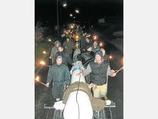
The maypole is set up in front of a inn in the community.
The tree must be at least 30 m tall and 100 years old.
Men from the community cut the Maypole.
They cut it between Christmas and 6 of Janury.
3 days before May 1st, they bring it to the front of the inn.
People from other communities are allowed to steal the tree secretly.
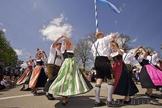
So that the maypole can be set up on May 1st, the people who stole it want a free snack, before they give it back.
Then on May 1st all people from the community go to the inn to drink, eat and celebrate.
The marching band from the community plays and the people dance traditional dances.
Traditonal dance

a marching band
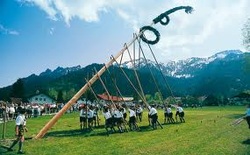
The maypole is set up by the men, who wear bavarian garb.
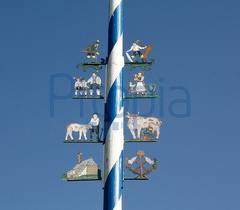
There are also some signs on the tree, which show the different businesses of the community.
Blog entry by Lauren Ellis and Katie McGrath.
From day to day we go from class to class learning something new every forty minutes. Five days a week we have Irish, English and Maths. As well as Irish we have to learn a second language, which is French. It is not a choice for us, but might be in some other schools around Ireland. There are five subjects we can choose from in our school, which are the following:
- Art
- Business
- Home-Economics
- Science
- Music
We all enjoy doing these subjects very much. The most common subjects that were kept in our class are Business, Art and Home-Economics. The teachers in our School are very kind and enthusiastic and take their job very seriously. They try their best to work their hardest in class to provide a good future for the students. They also have a laugh when it is suitable but make students get back to work when needed. All teachers in our school have a reputation that all their students get really good results in their junior certificate and leaving certificate. They do this by making sure our work is of the highest standards. "Setting standards and reaching goals" is how we put it.

Dublin Gaelic Football Jersey
GaelicFootball is a field game which has developed as a distinct game similar to the progression of Australian Rules. Gaelic Football is played on a pitch up to 145m long and 90m wide. The goalposts are the same shape as on a rugby pitch, with the crossbar lower than a rugby one and slightly higher than asoccer one.
The ball used in Gaelic Football is round, slightly smaller than a soccrt ball. It can be carried in the hand for a distance of four steps and can be kicked or "hand-passed", a striking motion with the hand or fist. After every four steps the ball must be either bounced or "solo-ed", an action of dropping the ball onto the foot and kicking it back into the hand. You may not bounce the ball twice in a row. To score, you put the ball over the crossbar by foot or hand / fist for one point or under the crossbar and into the net by foot or the hand / fist in certain circumstances for a goal, the latter being the equivalent of
three points. Each team consists of 15 players, lining out as per the diagram.
Officials for a game comprise of a referee, two linesmen (to indicate when the ball leaves the field of play at the side and to mark '45’ free kicks and four umpires (to signal scores, assist the referee in controlling the games, and to assist linesmen in positioning '45' frees). A goal is signalled by raising a green flag, placed to the left of the goal. A point is signalled by raising a white flag, placed to the right of goal. A '45' is signalled by the umpire raising his/her outside arm. A 'square ball', when a player scores having arrived in the 'square' prior to receiving the ball, is signalled by pointing at the small parallelogram.
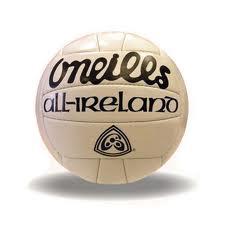
A typical Gaelic football.
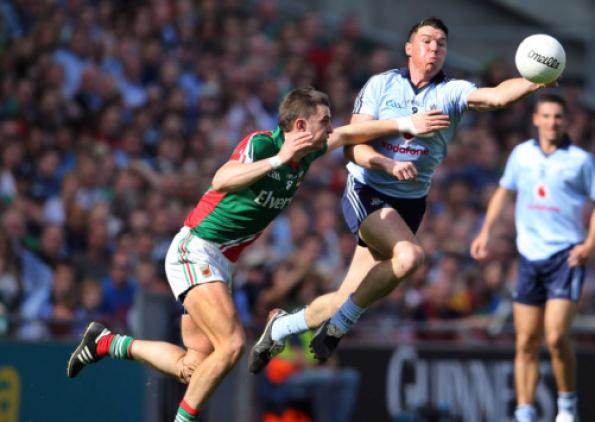
This is a Gaelic game (Dublin vs. Mayo) played in Croke Park, the GAA stadium.
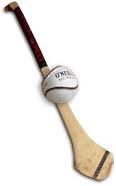
Hurling is believed to be the world’s oldest field game. When the Celts came to Ireland as the last ice age was receding, they brought with them a unique culture, their own language, music, script and unique pastimes. One of these pastimes was a game now called hurling. It features in Irish folklore to illustrate the deeds of heroic mystical figures and it is chronicled as a distinct Irish pastime for at least 2,000 years.
The stick, or "Hurley" (called camán in Irish) is curved outwards at the end, to provide the striking surface. The ball or "sliotar" is similar in size to a hockey ball but has raised ridges.
Hurling is played on a pitch that can be up to 145m long and 90m long. The goalposts are similar to those used on a rugby pitch, with the crossbar lower than in rugby and slightly higher than a soccer one.
You may strike the ball on the ground, or in the air. Unlike hockey, you may pick up the ball with your Hurley and carry it for not more than four steps in the hand. After those steps you may bounce the ball on the Hurley and back to the hand, but you are forbidden to catch the ball more than twice. To get around this, one of the skills is running with the ball balanced on the Hurley To score, you put the ball over the crossbar with the Hurley or under the crossbar and into the net by the Hurley for a goal, the latter being the equivalent of three points.
Each team is made up of 15 players with match officials and scoring values the same as in Gaelic Football.
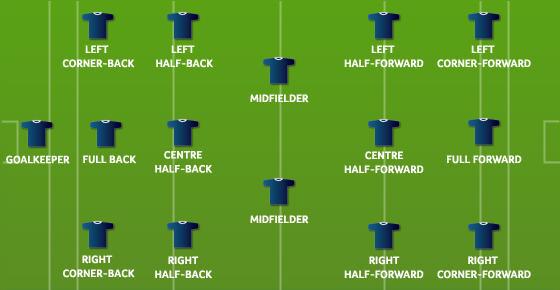
This is the way the team is set out for a 15 a-side game for hurling and camogie.
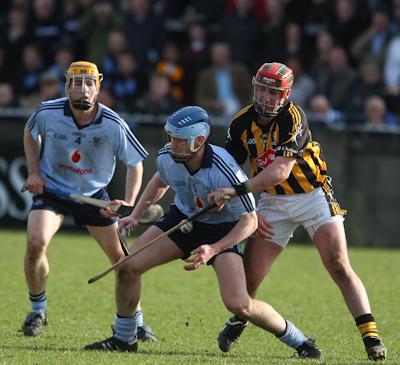
This is a Hurling game, Dublin vs Kilkenny.
Blog entry by Beth Whyte and Chelsea Lynham.















 RSS Feed
RSS Feed